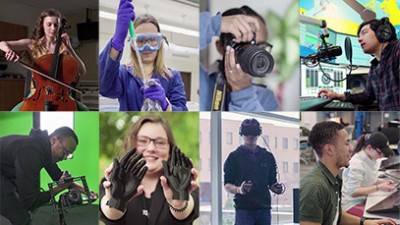RIT-RGHS Alliance Connects Medicine and Technology Through Innovation
In first year, partnership targets rapid advances in biomedical sciences, technology and education
Nate Pallace, RIT biomedical photographic communications major
Surgeons perform a breast reduction surgery using a pen-like device that is a CO2 laser for making incisions. The red beam of light is a guide, which provides the surgeon visual confirmation of where the laser beam cuts the skin.
Rochester General Hospital physicians and Rochester Institute of Technology faculty are partnering in areas related to biomedical research, telemedicine and robotics. RIT physician assistant students are part of clinical rotations while other students are observing surgeries at Rochester General Hospital as part of class projects. And both institutions are coordinating plans related to the H1N1 flu.
These are just some examples of collaboration between RIT and Rochester General Health System in the first year of a strategic alliance between the partners, first announced in December 2008. The boards of both organizations recently signed a joint affiliation agreement to formalize the partnership.
In a first-year progress report to both institutions and the Rochester community, RIT President Bill Destler states: “The alliance is off to a tremendous start. It is creating new opportunities for our students, faculty and staff that will ultimately benefit the greater Rochester community. Access to facilities and expertise available at Rochester General Hospital—as well as the health system’s other regional resources—provides obvious benefits to RIT educational and research programs.”
RGHS President and CEO Mark Clement is already observing the health system tapping into RIT’s resources and innovation, building on his organization’s health care services.
“As an organization committed to being on the leading edge in quality and patient care, we strongly believe that this partnership, which allows us to collaborate with experts in the field of biomedicine and science, will better serve our patients, enhance student education at RIT and create better health care services for our community,” Clement says. “The exciting progress and success we’ve achieved in just a short time in collaborative research and education bodes well for a long-standing and highly successful partnership.”
The alliance steering committee has identified a national strategic consulting firm to lead the two organizations in developing a clear vision, goals and objectives to help produce results. Tripp Umbach, based in Pittsburgh, provides research, planning and economic analysis to more than 500 leading organizations in health care, higher education, industry, government and community development.
“Creating the strategic plan with Tripp Umbach will assist both organizations in navigating complex issues as we move forward,” says Cindee Gray, managing director of the alliance. “The alliance is already creating newfound opportunities for physicians, faculty and students that will impact the delivery of quality healthcare for patients through enhanced education and research.”
Here are some of the achievements that have occurred to date:
- Research dollars have been funneled to RIT and RGHS via the federal American Recovery and Reinvestment Act. A portion of the funds will be used to enhance the scientific skills of RIT faculty now working with the Rochester General Research Institute.
- Joint vaccine research related to ear, eye, nose and throat infections.
- The establishment of a special phone line for student health referrals. The dedicated phone line will make access easier for students looking for general physicians or specialists. The number is 585-922-7480.
- The development of a radio-frequency identification system used to monitor hospital staff for compliance with hand-washing hygiene.
- The creation of a B.S./M.S. degree program in physician assistant studies awaits final approval from New York state. RGHS has agreed to help with the start of the program by already expanding its participation in the on-site, clinical internship-training phase of the curriculum.
- The development of a physician assistant residency-training program in surgery, designed for post-graduate physician assistants.
- A new course offered to biomedical photographic communications students. The class allows students to get hands-on photography experience in Rochester General operating rooms.
- The creation of co-op opportunities for information technology students to assist RGHS with technology needs.
A joint Web site now showcases the alliance achievements and serves as a tool to connect students, faculty and staff from both organizations. For more information, visit www.rit.edu/rghs.
About RIT: Rochester Institute of Technology is internationally recognized for academic leadership in computing, engineering, imaging technology, and fine and applied arts, in addition to unparalleled access and support services for deaf and hard-of-hearing students. Nearly 17,000 full- and part-time students are enrolled in more than 200 career-oriented and professional programs at RIT, and its cooperative education program is one of the oldest and largest in the nation. For two decades, U.S. News & World Report has ranked RIT among the nation’s leading comprehensive universities. RIT is featured in The Princeton Review’s 2010 edition of The Best 371 Colleges and in Barron’s Best Buys in Education. The Chronicle of Higher Education recognizes RIT as a “Great College to Work For.”
About RGHS: Rochester General Health System has been serving the community of Greater Rochester and beyond for more than 160 years and has earned national recognition for excellence in a variety of clinical specialties. Rochester General Hospital, the flagship of the system, is a 528-bed tertiary care facility that treats more Monroe County patients than any other hospital in the area. It is the fourth largest cardiac center in New York State and has been recognized as one of the nation’s 100 Top Cardiovascular Hospitals nine times. RGHS also includes Newark-Wayne Community Hospital, a 120-bed facility serving primarily Wayne County; two long-term care facilities—Hill Haven and DeMay Living Center; a Medical Group consisting of more than 40 primary care and specialty practices spread throughout Monroe and Wayne Counties; a Behavioral Health Network that provides adult and pediatric care; and Independent Living for Seniors, a program for seniors designed to enable the frail elderly to live in their own home, served by a network of supportive services.
Media Contact:
Michael Tedesco, RGHS
(585) 922-3677
Michael.Tedesco@rochestergeneral.org














